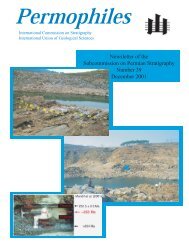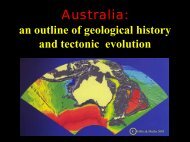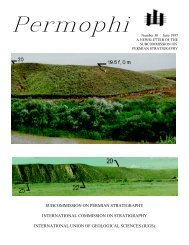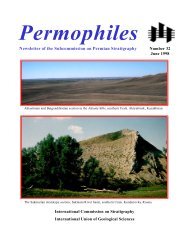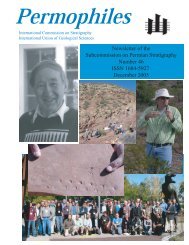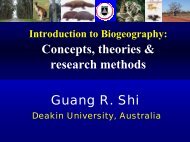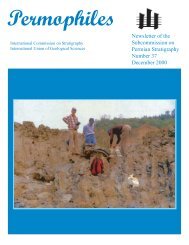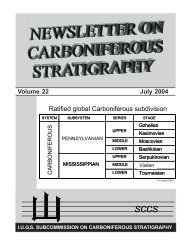Number 31 January 1998 Newsletter of the Subcommission on ...
Number 31 January 1998 Newsletter of the Subcommission on ...
Number 31 January 1998 Newsletter of the Subcommission on ...
You also want an ePaper? Increase the reach of your titles
YUMPU automatically turns print PDFs into web optimized ePapers that Google loves.
that are generally related to a<br />
“Namurian-Stephanian” interval. They infilled a<br />
large number <str<strong>on</strong>g>of</str<strong>on</strong>g> fault-bounded and<br />
intramountainous narrow and subsiding basins,<br />
which were mainly c<strong>on</strong>centrated al<strong>on</strong>g and near<br />
<str<strong>on</strong>g>the</str<strong>on</strong>g> most mobilized marginal areas <str<strong>on</strong>g>of</str<strong>on</strong>g> <str<strong>on</strong>g>the</str<strong>on</strong>g> Moesia<br />
and Balkan terranes.<br />
On <str<strong>on</strong>g>the</str<strong>on</strong>g> basis <str<strong>on</strong>g>of</str<strong>on</strong>g> <str<strong>on</strong>g>the</str<strong>on</strong>g> vertical and lateral distributi<strong>on</strong><br />
<str<strong>on</strong>g>of</str<strong>on</strong>g> <str<strong>on</strong>g>the</str<strong>on</strong>g>se early Late Palaeozoic products, we<br />
are led to recognize that depositi<strong>on</strong> was possibly<br />
cyclical.<br />
The first, or older Upper Carb<strong>on</strong>iferous cycle<br />
encompasses <str<strong>on</strong>g>the</str<strong>on</strong>g> “Namurian-Westphalian” sediments,<br />
from <str<strong>on</strong>g>the</str<strong>on</strong>g> boundary with <str<strong>on</strong>g>the</str<strong>on</strong>g> Variscan substratum<br />
up to about <str<strong>on</strong>g>the</str<strong>on</strong>g> top <str<strong>on</strong>g>of</str<strong>on</strong>g> <str<strong>on</strong>g>the</str<strong>on</strong>g> Series. Thus,<br />
this cycle appears to be c<strong>on</strong>fined between two<br />
unc<strong>on</strong>formities, which presumably coincide with<br />
<str<strong>on</strong>g>the</str<strong>on</strong>g> widely reported “Sudetian” and “Asturian”<br />
tect<strong>on</strong>ic phases.<br />
The sec<strong>on</strong>d, or younger Carb<strong>on</strong>iferous cycle<br />
begins with “Stephanian” sediments, and ends<br />
during <str<strong>on</strong>g>the</str<strong>on</strong>g> Lower Permian. Specifically, this cycle’s<br />
presence is suggested by a general switching <str<strong>on</strong>g>of</str<strong>on</strong>g><br />
<str<strong>on</strong>g>the</str<strong>on</strong>g> depositi<strong>on</strong>al areas, which generated new basins<br />
and extensively aband<strong>on</strong>ed o<str<strong>on</strong>g>the</str<strong>on</strong>g>r areas. It is<br />
highly probable, in this case too, that <str<strong>on</strong>g>the</str<strong>on</strong>g> Uppermost<br />
Carb<strong>on</strong>iferous-Lowermost Permian cycle<br />
developed between two unc<strong>on</strong>formities, which<br />
more or less coincide, respectively, with <str<strong>on</strong>g>the</str<strong>on</strong>g><br />
younger <strong>on</strong>e <str<strong>on</strong>g>of</str<strong>on</strong>g> <str<strong>on</strong>g>the</str<strong>on</strong>g> previous cycle and ano<str<strong>on</strong>g>the</str<strong>on</strong>g>r<br />
located inside <str<strong>on</strong>g>the</str<strong>on</strong>g> overlying Rotliegend units. In<br />
Bulgaria, according to Yanev (1981), <str<strong>on</strong>g>the</str<strong>on</strong>g> latter<br />
unc<strong>on</strong>formity marks <str<strong>on</strong>g>the</str<strong>on</strong>g> boundary between <str<strong>on</strong>g>the</str<strong>on</strong>g><br />
Lower and Upper Rotliegend, and is followed both<br />
by a progressive or abrupt disappearance <str<strong>on</strong>g>of</str<strong>on</strong>g> <str<strong>on</strong>g>the</str<strong>on</strong>g><br />
igneous, intrusive and extrusive deposits, and by<br />
<str<strong>on</strong>g>the</str<strong>on</strong>g> <strong>on</strong>set <str<strong>on</strong>g>of</str<strong>on</strong>g> differing sedimentary and structural<br />
features. In a Permian excursus, this unc<strong>on</strong>formity<br />
could be reas<strong>on</strong>ably correlated with <str<strong>on</strong>g>the</str<strong>on</strong>g> main<br />
“Saalian” tect<strong>on</strong>ic phase proposed by German<br />
authors.<br />
The subsequent third cycle, which includes <str<strong>on</strong>g>the</str<strong>on</strong>g><br />
Upper Rotliegend sediments, probably extended<br />
from undefined Early Permian times to <str<strong>on</strong>g>the</str<strong>on</strong>g> beginning<br />
<str<strong>on</strong>g>of</str<strong>on</strong>g> Late Permian. It is delimited by <str<strong>on</strong>g>the</str<strong>on</strong>g> sec<strong>on</strong>d<br />
<str<strong>on</strong>g>of</str<strong>on</strong>g> <str<strong>on</strong>g>the</str<strong>on</strong>g> aforementi<strong>on</strong>ed unc<strong>on</strong>formities and by ano<str<strong>on</strong>g>the</str<strong>on</strong>g>r<br />
<strong>on</strong>e, which expresses itself markedly and<br />
extensively in <str<strong>on</strong>g>the</str<strong>on</strong>g> present Bulgaria and abroad.<br />
This younger unc<strong>on</strong>formity is generally related<br />
to a plate structural reorganizati<strong>on</strong> <str<strong>on</strong>g>of</str<strong>on</strong>g> vast European<br />
regi<strong>on</strong>s, which was probably caused by a<br />
major extensi<strong>on</strong>al activity. In o<str<strong>on</strong>g>the</str<strong>on</strong>g>r European regi<strong>on</strong>s,<br />
this disc<strong>on</strong>tinuity has variously been identified<br />
with <str<strong>on</strong>g>the</str<strong>on</strong>g> “Palatine” tect<strong>on</strong>ic phase (e.g.,<br />
Kozur, 1980), and with <str<strong>on</strong>g>the</str<strong>on</strong>g> “post-Saalian” or <str<strong>on</strong>g>the</str<strong>on</strong>g><br />
“Altmark” phases (e.g., H<str<strong>on</strong>g>of</str<strong>on</strong>g>fmann et al., 1989).<br />
As a c<strong>on</strong>sequence, <str<strong>on</strong>g>the</str<strong>on</strong>g> overlying Upper Per-<br />
Figure 3. Schematic, n<strong>on</strong>-palinspastic secti<strong>on</strong>s through <str<strong>on</strong>g>the</str<strong>on</strong>g> Permian <str<strong>on</strong>g>of</str<strong>on</strong>g> Bulgaria, before depositi<strong>on</strong> <str<strong>on</strong>g>of</str<strong>on</strong>g> Lower Triassic clastic redbeds. Secti<strong>on</strong> traces<br />
in Fig.2B; lateral and vertical distances not in scale. Symbols: Pz = Palaeozoic; O1 = Lower Ordovician; D = Dev<strong>on</strong>ian; C1 = Lower Carb<strong>on</strong>iferous;<br />
C1V2 and C1V3 = Lower Carb<strong>on</strong>iferous - Visean; C2 = Upper Carb<strong>on</strong>iferous; C2N = Upper Carb<strong>on</strong>iferous - Namurian; C2S = Upper Carb<strong>on</strong>iferous -<br />
Stephanian; P1 = Lower Permian; P11 = Lower Rotliegend; P12 = Upper Rotliegend; P2 = Upper Permian; T = Triassic.<br />
29



